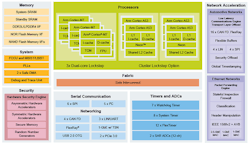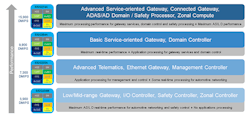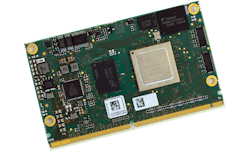SoC Steers Toward Zonal Automotive Gateways
NXP is now delivering its TEF82xx radar transceiver and S32R2 radar processing unit that were announced at the start of the year. At its NXP Technology Days, the company also has been highlighting the S32G2 system-on-chip (SoC), which targets automotive gateways for the zonal approach to implementing control systems in the smart car (Fig. 1).
The zonal approach to a vehicle control system moves more of the functionality into software, where it can be located in different portions of the network. This is in contrast to a more conventional domain-oriented approach, where dedicated functions are found in an electronic control unit (ECU) that’s then networked.
The S32G2 is designed to meet ASIL-D requirements as well as provide a range of communication options, from Flexray to automotive Ethernet (Fig. 2). In addition to CAN FD and Flexray support, the SoC includes a programmable network accelerator for three Ethernet ports, including one 2.5-Gb/s interface.
On top of that, there’s a multiport Ethernet switch, plus on-chip PHYs support 100BASE-T1/TX. The Ethernet MACs can use off-chip PHYs for 1- and 2.5-Gb Ethernet connectivity. The network API allows developers to configure and accelerate network functions such as VPN support without burdening either processor complex.
The SoC is able to handle real-time chores without resorting to an external processor via a lockstep-enabled Cortex-M7 cluster. Even the main Cortex-A53 cluster supports lockstep operation. The application cluster supports hypervisors from Green Hills Software, OpenSynergy, QNX, Wind River, and XEN. Connections to AWS and Cloudera are available for services ranging from over-the-air (OTA) updates to vehicle health. Compilers from Green Hills Software, IAR Systems, and Wind River support the real-time cluster as well.
The S32G2 family starts with the S32G324M SoC, which foregoes the application processor cluster that’s designed for zonal controller applications (Fig. 3). At the top end is a quad-core Cortex-A53-based SoC that targets compute and gateway functionality.
Developers can get started with the S32G2 Goldbox reference design (Fig. 4). This rugged, air-cooled system supports the range of NXP tools and third-party integration, including support for various cloud and service providers. The Goldbox contains the RDB2 S32G reference design board.
About the Author
William G. Wong
Senior Content Director - Electronic Design and Microwaves & RF
I am Editor of Electronic Design focusing on embedded, software, and systems. As Senior Content Director, I also manage Microwaves & RF and I work with a great team of editors to provide engineers, programmers, developers and technical managers with interesting and useful articles and videos on a regular basis. Check out our free newsletters to see the latest content.
You can send press releases for new products for possible coverage on the website. I am also interested in receiving contributed articles for publishing on our website. Use our template and send to me along with a signed release form.
Check out my blog, AltEmbedded on Electronic Design, as well as his latest articles on this site that are listed below.
You can visit my social media via these links:
- AltEmbedded on Electronic Design
- Bill Wong on Facebook
- @AltEmbedded on Twitter
- Bill Wong on LinkedIn
I earned a Bachelor of Electrical Engineering at the Georgia Institute of Technology and a Masters in Computer Science from Rutgers University. I still do a bit of programming using everything from C and C++ to Rust and Ada/SPARK. I do a bit of PHP programming for Drupal websites. I have posted a few Drupal modules.
I still get a hand on software and electronic hardware. Some of this can be found on our Kit Close-Up video series. You can also see me on many of our TechXchange Talk videos. I am interested in a range of projects from robotics to artificial intelligence.






